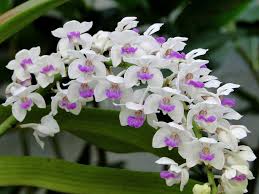# How to Create a Mini White Egg Orchid Garden for Your Living Space

## Table of Contents
1. **Introduction**
2. **Understanding White Egg Orchids**
– 2.1. Botanical Overview
– 2.2. Unique Characteristics
3. **Planning Your Mini Orchid Garden**
– 3.1. Assessing Your Space
– 3.2. Choosing the Right Location
– 3.3. Designing the Layout
4. **Selecting White Egg Orchids**
– 4.1. Choosing Healthy Plants
– 4.2. Varieties and Cultivars
5. **Essential Supplies and Materials**
– 5.1. Potting Medium
– 5.2. Containers and Pots
– 5.3. Fertilizers and Nutrients
6. **Creating the Perfect Growing Environment**
– 6.1. Light Requirements
– 6.2. Temperature and Humidity
– 6.3. Air Circulation
7. **Planting Your White Egg Orchids**
– 7.1. Preparing the Pots
– 7.2. Planting Techniques
– 7.3. Watering Strategies
8. **Caring for Your Mini Orchid Garden**
– 8.1. Watering and Feeding
– 8.2. Pruning and Maintenance
– 8.3. Pest and Disease Control
9. **Enhancing Your Garden’s Aesthetic**
– 9.1. Decorative Elements
– 9.2. Companion Plants
– 9.3. Arrangement Ideas
10. **Long-Term Care and Management**
– 10.1. Seasonal Considerations
– 10.2. Repotting and Propagation
11. **Conclusion**
12. **FAQs**
—
## 1. Introduction
Creating a mini garden of White Egg Orchids (*Phalaenopsis*) can enhance the beauty of your living space while providing a calming atmosphere. These stunning orchids, known for their elegant white blooms, can be grown successfully in small spaces, making them ideal for homes, apartments, or even offices. In this guide, we will explore the steps to establish and maintain a thriving mini orchid garden.
## 2. Understanding White Egg Orchids
### 2.1. Botanical Overview
White Egg Orchids belong to the genus *Phalaenopsis*, one of the most popular orchid genera among gardeners. They are appreciated for their long-lasting flowers and low maintenance requirements.
– **Genus:** *Phalaenopsis*
– **Family:** Orchidaceae
– **Native Range:** Southeast Asia, including regions like Indonesia and the Philippines.
### 2.2. Unique Characteristics
These orchids feature broad, flat petals that form a delicate, moth-like shape. Their blooms can last for several weeks, making them a perfect addition to any indoor garden. Additionally, their adaptability to various indoor conditions contributes to their popularity.
## 3. Planning Your Mini Orchid Garden
### 3.1. Assessing Your Space
Before diving into the creation of your mini orchid garden, assess your available space. Consider areas in your home that receive adequate light and have stable temperatures. Windowsills, shelves, or even dedicated plant stands can serve as excellent locations.
### 3.2. Choosing the Right Location
White Egg Orchids thrive in bright, indirect sunlight. Choose a location that receives filtered sunlight, such as near a south or east-facing window. Avoid direct sunlight, which can scorch the leaves.
### 3.3. Designing the Layout
Plan the layout of your mini garden. You can create a cluster of orchids in one area or arrange them along shelves for a cascading effect. Consider the height of the plants, ensuring that taller orchids do not overshadow shorter ones.
## 4. Selecting White Egg Orchids
### 4.1. Choosing Healthy Plants
When selecting your orchids, look for healthy specimens with vibrant green leaves and no signs of yellowing or damage. Ensure the roots are firm and white, indicating a healthy root system.
### 4.2. Varieties and Cultivars
While the White Egg Orchid is known for its striking white blooms, consider exploring different varieties that may offer subtle differences in shape or fragrance. Some cultivars may also feature slight variations in color or pattern.
## 5. Essential Supplies and Materials
### 5.1. Potting Medium
Choosing the right potting medium is crucial for orchid health. Use a well-draining orchid mix that typically consists of bark, sphagnum moss, and perlite. This ensures proper aeration and moisture retention.
### 5.2. Containers and Pots
Select pots with drainage holes to prevent waterlogging. You can choose decorative pots or traditional orchid pots. Ensure the size of the pot is appropriate for the size of the orchid.
### 5.3. Fertilizers and Nutrients
Orchids require specific nutrients to thrive. Use a balanced orchid fertilizer, preferably one formulated for *Phalaenopsis* orchids, and follow the manufacturer’s instructions for application.
## 6. Creating the Perfect Growing Environment
### 6.1. Light Requirements
White Egg Orchids prefer bright, indirect light. If your space lacks adequate natural light, consider using grow lights to supplement. Position the lights about 12-18 inches above the plants, providing around 12-14 hours of light daily.
### 6.2. Temperature and Humidity
Maintaining the right temperature and humidity is essential for orchid health. White Egg Orchids thrive in temperatures between 70°F and 80°F (21°C to 27°C) during the day, with a slight drop at night. Aim for humidity levels of 50-70%. You can use a humidity tray filled with water and pebbles or a humidifier to maintain moisture.
### 6.3. Air Circulation
Good air circulation is crucial to prevent fungal diseases and pests. Ensure that your mini garden has adequate ventilation, especially if you are using a closed environment like a terrarium.
## 7. Planting Your White Egg Orchids
### 7.1. Preparing the Pots
Before planting, ensure that your pots are clean and free from contaminants. Rinse the pots with warm soapy water and rinse thoroughly.
### 7.2. Planting Techniques
1. **Fill the Pot:** Add the potting medium to the pot, filling it about two-thirds full.
2. **Position the Orchid:** Carefully remove the orchid from its nursery pot and gently separate any tightly bound roots. Place the orchid in the pot, ensuring the crown (where the leaves meet the roots) is above the medium.
3. **Add More Medium:** Fill in around the roots with the potting medium, gently pressing it down to eliminate air pockets.
### 7.3. Watering Strategies
After planting, water the orchids thoroughly. Allow excess water to drain completely. Watering frequency will depend on the environment; typically, orchids should be watered every 7-10 days, allowing the medium to dry slightly between waterings.
## 8. Caring for Your Mini Orchid Garden
### 8.1. Watering and Feeding
Maintain a consistent watering schedule, checking the moisture level of the potting medium. Use a diluted orchid fertilizer every two to four weeks during the growing season (spring and summer) to provide essential nutrients.
### 8.2. Pruning and Maintenance
Regular maintenance includes removing dead or yellowing leaves and spent flower spikes. Prune back flower spikes after blooming to encourage new growth.
### 8.3. Pest and Disease Control
Keep an eye out for common pests such as aphids, mealybugs, and spider mites. Use insecticidal soap or neem oil to manage infestations. Regularly inspect your plants for signs of disease, such as black spots or wilting leaves.
## 9. Enhancing Your Garden’s Aesthetic
### 9.1. Decorative Elements
Incorporate decorative elements such as stones, figurines, or driftwood to enhance the visual appeal of your mini garden. These can create a focal point and complement the natural beauty of the orchids.
### 9.2. Companion Plants
Consider adding companion plants that thrive in similar conditions, such as ferns or other low-light tolerant houseplants. This creates a lush, diverse garden and helps maintain humidity.
### 9.3. Arrangement Ideas
Experiment with different arrangements. You can create height variations by using stands or placing smaller pots on elevated surfaces. Grouping orchids of different heights and colors adds depth to your display.
## 10. Long-Term Care and Management
### 10.1. Seasonal Considerations
Adjust your care routine with the changing seasons. In the winter months, reduce watering and fertilizer as the orchids enter a dormant period. Maintain a stable temperature and humidity to prevent stress.
### 10.2. Repotting and Propagation
Repot your orchids every 1-2 years or when they outgrow their containers. Use this opportunity to check for root health and replace the potting medium. You can also propagate your orchids through division if the plant has multiple stems.
## 11. Conclusion
Creating a mini garden of White Egg Orchids is a rewarding experience that can transform your living space into a serene and beautiful environment. By following the steps outlined in this guide, you can successfully cultivate and maintain a thriving orchid garden, bringing joy and elegance to your home for years to come.
## 12. FAQs
### Q1: How often should I water my White Egg Orchids?
**A1:** Water your orchids every 7-10 days, allowing the potting medium to dry slightly between waterings.
### Q2: Can I grow White Egg Orchids without natural light?
**A2:** Yes, you can use grow lights to provide the necessary light for your
orchids if natural light is insufficient.
### Q3: What is the ideal temperature for growing White Egg Orchids?
**A3:** White Egg Orchids thrive in temperatures between 70°F and 80°F (21°C to 27°C) during the day.
### Q4: How can I tell if my orchids are getting enough light?
**A4:** Healthy orchids will have vibrant green leaves. If leaves turn yellow or become very dark green, it may indicate insufficient or excessive light, respectively.
### Q5: What should I do if my orchids stop blooming?
**A5:** Ensure they are receiving adequate light, water, and nutrients. Sometimes, a rest period is needed for orchids to bloom again.
—
By following this comprehensive guide, you will be well-equipped to create and maintain a mini White Egg Orchid garden that will flourish in your living space. Happy gardening!

